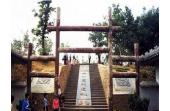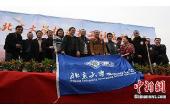Yinxu
- Things to do
-
- Photo(10)
- Tips&article(5)
- Make it Happen
- Map
-
loading...
- Other Tours
Yinxu, the ruins of the last capital of China's Shang Dynasty (1766 BC - 1050 BC), is one of the oldest and largest archaeological sites in China and is one of the Historical capitals of China and a UNESCO World Heritage Site. It is located near the modern city of Anyang; just about two hours drive from Zhengzhou city.
Yin, or rather, Yinxu, is now partly buried beneath the city of Xiaotun, which is a small village located on the northwestern outskirts of the city of An'yang, in the part of present-day Henan Province that neighbors Hubei and Shanxi Provinces to the north.
More than just the usual set of stone foundations that mark a forgotten city, Yinxu has yielded up a plethora of fascinating archeological artifacts, including palatial buildings, complete tombs, and written records in the form of so-called oracle bones, or large pieces of cracked bone or turtle shell which were heated and cracked during divination and on which were then inscribed – in a unique script that is the precursor to the Chinese character script – the record of the divination.
Not surprisingly, Yinxu has become a famous historical and cultural city in China in which not only the Chinese people can take pride, but all of mankind can take pride, Yinxu being recognized as a milestone – with all its horrors as well as its splendors (the ritual execution of humans was part and parcel of life in this slave society) – on the social development path of the species.
How Yinxu was discovered is itself almost as unique as what was unearthed here. In 1899 the director of the Imperial Collage, who suffered from malaria, had succumbed to one of the usual periodic bouts of fever associated with the illness, but the pharmacist on this occasion offered the director a new "drug", namely, "Longgu", or "dragon bones". What the good director received were some small, flat pieces of bone material that obviously belonged to a larger flat bone and upon which one could distinctly make out etchings that vaguely resembled the Chinese character script.
Being a man of letters, the director naturally imagined that what he held in his hand might be a shard from a larger piece of ancient bone material that had been used as a sort of ledger to record important data – perhaps a harvest record or a record of grain purchase – and that there might be more such bone material at the same location, if it could be found. The director, with the help of an assistant, quickly traced the magic "malaria drug" to the small village of Xiaotun on the outskirts of An'yang, and there a great number of similar bone shards were unearthed.
Enough pieces of "ledger" had been found by 1917 to permit Wang Guowei, a Chinese scholar, writer and poet, to discipher the "oracle bone" inscriptions, as they had been dubbed. The information that the oracle bones held related to the geneology of the rulers of an ancient Chinese dynasty whose existence, though recorded in the Records of the Grand Historian by Sima Qian as the Shang Dynasty, was thought to be more fanciful than factual. Here then was actual proof of the existence of the Shang Dynasty and its capital city, Yin.
The first round of excavations at Yinxu took place between 1928-37, conducted by the Chinese Institute of History and Philosophy, which undertook archeological digs at the time. The remains of a royal palace, royal tombs, and an immense quantity – more than a hundred thousand – oracle bones which would reveal the "written language" of these ancient Chinese forebears, were unearthed.
Further excavations have been carried out beginning in 1950 by the Archeological Institute of the Chinese Social Sciences Academy. The Archeological Institute found evidence of stratification, suggesting that the Shang Dynasty was indeed of long duration. The remains of palaces and temples as well as royal cemeteries were discovered, and in the process the institute learned much about the art and science of archeological digging, thus laying the groundwork for future excavation projects, of which there would be many in the new China.
The scale of Yinxu was enormous. A five-sided construction, the city ran from Beixinzhuang in the west to Houying in the north, to Sanjiazhuang in the northeast, to Guojiawan in the east, and finally, to Liujiazhuang in the south. Yinxu was roughly 6 kilometers long and 5 kilometers wide, covering an area of 24,000 square kilometers.
The layout of Yinxu was such that it radiated out along one side of the Huan River, with the Ancestral Temple at Xiaotun Palace (a name later given to the palace ruins) at its center. The city had no walls, evidence perhaps of the expanse and the degree of authority that the king exercised in this slave society.
Many noteworthy sites have been excavated at Yinxu besides the Ancestral Temple: the Mausoleum, the site of Hougang, the Tomb of Fu Hao and the Exhibition Hall of Chariot Pits. Lady (Queen) Fu Hao was a military leader (!) and wife of King Wu Ding. In addition to the remains of the queen, there were skeletal remains of six dogs and sixteen slaves in the tomb.
The tomb also contained numerous other precious items befitting a queen, including earthenware and jewelry. The city of Yin was truly the spiritual and cultural center of the Yin Dynasty, which is the name that historians have given to the final years of the Shang Dynasty.
The Exhibition Hall of Chariot Pits served up some rare animal-driven carts, and in each of the six pits were found the remains of a carriage and a team of horses. There were also remains of further human sacrifices, including a child, in five of these pits. Other sites within the excavation complex revealed caves and family tombs, and artifacts suggesting the existence of tribes, or large families. Various workshops were also unearthed, including workshops for the casting of copper and the making of jade.
All of these finds have been carefully preserved and put on display at the museum complex, which in fact forms a park, so plentiful have been the archeological finds here. Other finds relating to the Shang Dynasty continue to be found in the region, and they too are collected and put on display at Yinxu Museum.
The park can be separated into two parts: one which focuses specifically on the oracle bones and the desciphering of their inscriptions; and one which focuses on the life and times – and chronology – of the Shang Dynasty. The visitor will note that the appearance of the park's gate is strikingly odd.
The explanation is that it is deliberately crafted so that its outline follows that of the oracle-bone-script word for "gate".
In 2006 Yinxu was inscribed as a UNESCO World Heritage Site.
- Zhengzhou Attraction List
- About Chinese Museums
- About Chinese History
- Contact Us for Tailor-Made Tours
Tips & articles
|
|
|
forum discussion
|
|











